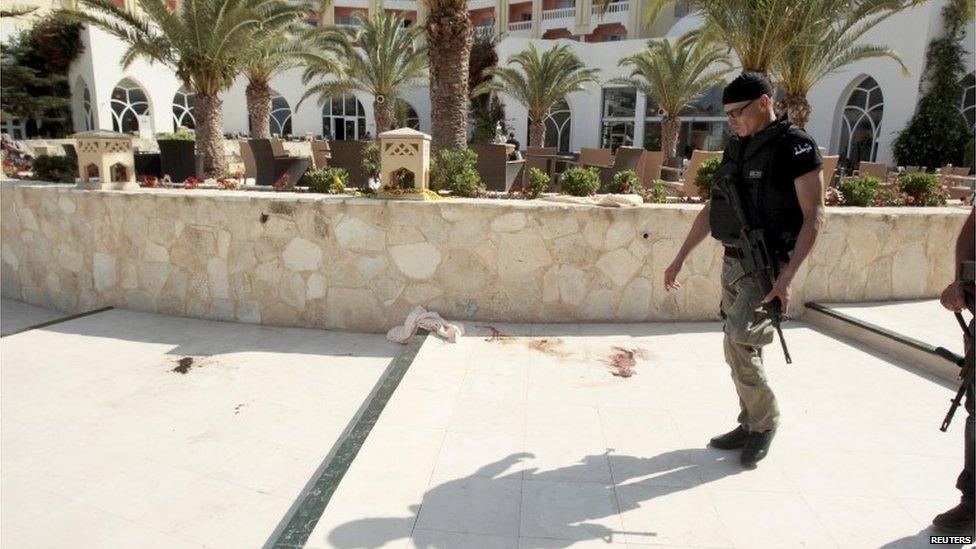Tunisia, Kuwait and France: Are attacks connected?
- Published


Tunisia
This is the second major attack of the year, following the attack at the Bardo museum in Tunis three months ago that left 22 people dead. Once more, tourists and the tourism industry - an important source of revenue for Tunisia - were targeted.
Until 2011, Tunisia was an authoritarian state that developed an extensive security apparatus. Political Islam was suppressed, often ruthlessly. Since former president Zine al-Abidine Ben Ali was toppled, politics has been volatile and the security situation more fluid.
That leaves the country exposed to two particular risks - the possible return home of some of the large number of Tunisians who have left the country to fight in Iraq and Syria, and the growing radical Islamist presence in neighbouring Libya.
Beyond tourism, the attacks undermine the state and deter foreign investment. Cruelly, the solitary success of Tunisia's political transition may have made it more of a target, as Islamists try to throw the birthplace of the Arab Spring off course.

Kuwait
Of the three attacks, the one in Kuwait may come as most of a shock. The suicide bombing against a mosque east of Kuwait City was unprecedented in the tiny, rich, oil-producing country, previously a beacon of stability in a troubled region.
Kuwait is majority Sunni country, with a large Shia minority and no history of serious sectarian tension. However, in neighbouring Saudi Arabia there have recently been attacks against mosques in the east of the country, where the country's Shia minority is based.
More broadly, the attack in Kuwait may be viewed as a sign of the spread of sectarian violence fuelled by competition between Iran and Saudi Arabia for regional power. An affiliate of the Islamic State (IS) said it carried out the attack, and Shia Muslims are considered to be heretical by the group.

France
France is home to the largest Muslim population in Western Europe and has seen occasional Islamist attacks since the 1990s. By far the most dramatic recent attacks were those launched in Paris against the satirical magazine Charlie Hebdo and a Jewish supermarket in January.
Afterwards, the government rapidly deployed major security reinforcements to sites that were considered at risk and moved to reinforce the capacity of the intelligence services.
So the fact that the suspect in Friday's attack had been investigated over possible ties to radical Islam before 2008 but that those investigations had then been stopped will raise fresh worries over the challenge of picking up on real threats from among the thousands of people that the security services say they need to monitor.

What we know about the attacks
The attack in France bears hallmarks of some of the most gruesome Islamist violence in the Middle East - a decapitated head placed on a post, and a possible attempt to cause a major explosion. But it could also fall into the category of a "lone wolf" attack against an individual at an obscure site - perhaps even a personal grievance dressed up as Islamist extremism.
The attacks in Tunisia and Kuwait replicate more closely those carried out previously by Islamist extremists in the Middle East and North Africa. Taking place on a Friday, they are symbols of the troubled legacy of uprisings that shook the Arab world in 2011. Once the day of optimistic Arab Spring protests, it is now often the day chosen for sectarian attacks against mosques.
The attacks also happened in the first week of the Muslim holy month of Ramadan, a period when - dating back at least to the civil conflict in Algeria in the 1990s - extremists have intensified their campaigns. On Tuesday, an IS spokesman urged followers to step up attacks during Ramadan, and the group has appealed to its supporters to spread their attacks beyond Iraq and Syria.
Friday's attacks could be a sign of the group's growing reach, or that its adherents are lashing out further afield in an effort to sustain the group's momentum.
It is often hard to prove the links between separate cases of bloodshed, even when claims of responsibility are issued by the same group. Violence is often driven by local grievances, with militant factions switching allegiances as the fortunes of bigger international "franchises" like al-Qaeda and Islamic State rise and fall. That leads to uncertainty as to whether the bigger group directed, co-ordinated, or inspired a given attack, or simply claimed it after the fact.
That is one aspect that officials and security analysts will be seeking to understand in the aftermath of this bloody day.